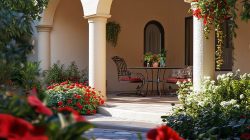Introduction
Are you making common EIFS repair mistakes? Exterior Insulation and Finish Systems (EIFS) are a popular choice for both residential and commercial buildings due to their energy efficiency and aesthetic appeal. However, when it comes to repairing and maintaining your EIFS, there are several pitfalls that you might unknowingly fall into. In this article, we will explore the top three EIFS repair mistakes you might be making and how to avoid them.
What is EIFS?
Components of EIFS
EIFS is a multi-layered exterior wall cladding system that consists of an insulation board, a base coat, a reinforcement mesh, and a finish coat. This system provides an effective thermal barrier for the building, reducing energy costs and improving comfort levels for occupants.
Benefits of EIFS
There are several reasons why EIFS has become popular, including energy efficiency, design flexibility, and durability. EIFS can be customized to mimic various architectural styles, and its lightweight nature allows for easy installation on a variety of building types.
Mistake 1: DIY Repairs
Lack of proper tools and experience
One of the most common EIFS repair mistakes is attempting to fix the issue yourself without the necessary tools and expertise. EIFS is a complex system that requires specialized knowledge and skills to repair correctly. You may end up causing more harm than good if you don’t know what you’re doing.
Consequences of DIY repairs
By attempting DIY repairs, you risk compromising the integrity of the EIFS system. This can lead to further damage, including water intrusion, mold growth, and structural issues. Additionally, improper repairs may void the warranty of your EIFS system, leaving you on the hook for expensive repairs or replacements.
Mistake 2: Using Incompatible Materials
How to choose the right materials
Another common mistake is using incompatible materials for your EIFS repairs. It is crucial to use the same materials and components recommended by the EIFS manufacturer to ensure the system functions as intended. This includes selecting the right type of insulation, base coat, reinforcement mesh, and finish coat.
Damage caused by incompatible materials
Using the wrong materials can lead to a variety of issues, such as poor adhesion between layers, cracks in the finish coat, and decreased energy efficiency. Moreover, incompatible materials can cause chemical reactions, resulting in discoloration and deterioration of the EIFS system. To avoid these problems, always follow the manufacturer’s guidelines and consult with a professional EIFS contractor when in doubt.
Mistake 3: Ignoring Water Intrusion and Drainage Issues
Identifying signs of water intrusion
Water intrusion is a common problem with EIFS systems if not properly installed or maintained. Ignoring signs of water intrusion can lead to severe damage to both the EIFS and the underlying structure. Be vigilant in looking for signs such as bulging or cracked finish coats, mold or mildew growth, and damp or discolored interior walls.
Importance of proper drainage
A well-functioning EIFS system should have adequate drainage to prevent water from accumulating behind the insulation board. Neglecting drainage issues can result in water intrusion, which may cause rot, mold, and other structural problems. Ensure that your EIFS system is properly designed and installed to promote effective water drainage.
How to Avoid These Mistakes
Hiring a professional EIFS contractor
The best way to avoid common EIFS repair mistakes is by hiring a professional EIFS contractor. These experts have the knowledge, experience, and tools necessary to identify and address any issues with your EIFS system. They can also provide guidance on proper maintenance and inspection routines to help you keep your EIFS in top condition.
Regular inspection and maintenance
Routine inspection and maintenance are essential for the longevity of your EIFS system. By regularly inspecting your EIFS for signs of damage, you can address any issues before they become more severe and costly to repair. It’s a good idea to schedule annual inspections with a professional EIFS contractor to ensure the continued performance of your system.
Conclusion
EIFS is an excellent choice for energy-efficient and aesthetically pleasing building exteriors. However, to ensure the longevity and performance of your EIFS system, it’s crucial to avoid the common repair mistakes outlined in this article. By hiring a professional EIFS contractor and adhering to regular maintenance routines, you can protect your investment and enjoy the benefits of your EIFS for years to come.
Frequently Asked Questions
1. How can I tell if my EIFS system is damaged?
Common signs of EIFS damage include cracks or bulges in the finish coat, discoloration, mold or mildew growth, and damp or discolored interior walls. If you notice any of these issues, it’s essential to consult with a professional EIFS contractor for a thorough inspection and repair.
2. Can I paint over my EIFS system?
Yes, you can paint over your EIFS system, but it’s essential to use the right type of paint and follow proper procedures. Consult with a professional EIFS contractor or the manufacturer’s guidelines to ensure you choose the correct paint and application method.
3. How often should I have my EIFS system inspected?
It’s recommended to have your EIFS system inspected at least once a year by a professional EIFS contractor. Regular inspections can help identify potential issues and ensure the ongoing performance and durability of your system.
4. Can EIFS be installed over existing siding?
In some cases, EIFS can be installed over existing siding, but it depends on the condition of the underlying material and the compatibility with the EIFS system. Always consult with a professional EIFS contractor to determine the best course of action for your specific situation.
5. How long does EIFS last?
With proper installation, maintenance, and repair, EIFS can last for several decades.


